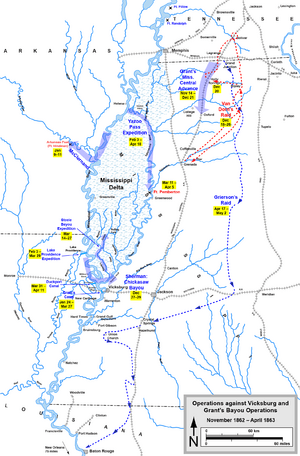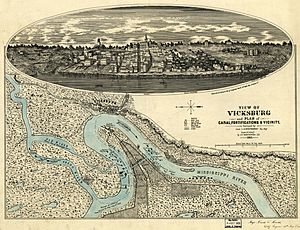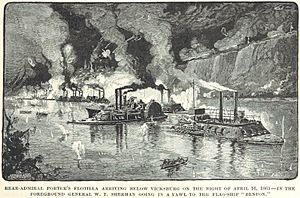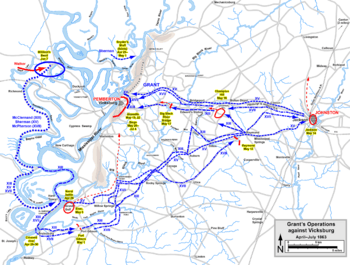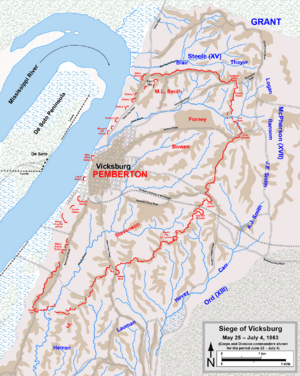Vicksburg campaign facts for kids
Quick facts for kids Vicksburg campaign |
|||||||
|---|---|---|---|---|---|---|---|
| Part of the American Civil War | |||||||
 Lithograph of the Mississippi River Squadron running the Confederate blockade at Vicksburg on April 16, 1863 |
|||||||
|
|||||||
| Belligerents | |||||||
| Commanders and leaders | |||||||
| Units involved | |||||||
| Army of the Tennessee | Army of Mississippi | ||||||
| Strength | |||||||
| ~28,800–73,095 | ~43,600–65,800 (aggregate of Pemberton and Johnston) | ||||||
| Casualties and losses | |||||||
| 10,142 total
(1,581 killed
7,554 wounded 1,007 missing) |
38,586 total
(1,413 killed
3,878 wounded 3,800 missing 29,495 surrendered) |
||||||
The Vicksburg campaign was a series of important military actions during the American Civil War. It focused on capturing Vicksburg, Mississippi. This city was a strong fortress that controlled the last part of the Mississippi River held by the Confederates.
The Union forces, led by Major General Ulysses S. Grant, wanted to take control of the entire river. They did this by capturing Vicksburg and defeating the Confederate forces there. These forces were led by Lieutenant General John C. Pemberton.
The campaign included many naval operations, troop movements, and eleven battles. It lasted from December 26, 1862, to July 4, 1863. Historians divide it into two main parts: "operations against Vicksburg" (December 1862 – January 1863) and "Grant's operations against Vicksburg" (March – July 1863).
Grant first tried a plan where half his army, led by Maj. Gen. William Tecumseh Sherman, would attack Vicksburg from the northeast. Grant would take the rest of his army overland. Both parts of this plan failed. Grant then tried several "bayou operations" to get his boats past Vicksburg's defenses by water. These also failed.
Finally, Union gunboats and transport boats bravely sailed past Vicksburg's powerful cannons. Grant's soldiers marched overland in Louisiana to meet them. On April 29 and 30, 1863, Grant's army crossed the Mississippi River. They landed safely at Bruinsburg, Mississippi, surprising the Confederates. Over the next 17 days, Grant's army moved inland. They won five battles, captured the state capital of Jackson, Mississippi, and then attacked Vicksburg. They then began a long siege of the city.
Pemberton's army surrendered on July 4, 1863. This happened one day after a major Confederate defeat at Gettysburg. When Port Hudson also surrendered on July 9, the states of Texas and Arkansas were cut off from the rest of the Confederacy. The Mississippi River was now fully open for Union ships. This campaign is seen as a brilliant military operation. It was a major turning point in the war.
Contents
Why Vicksburg Was Important
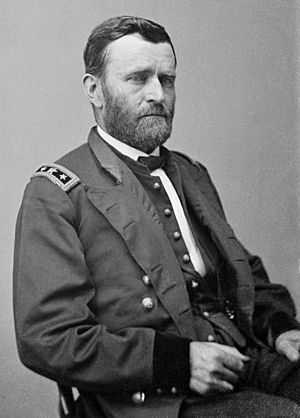
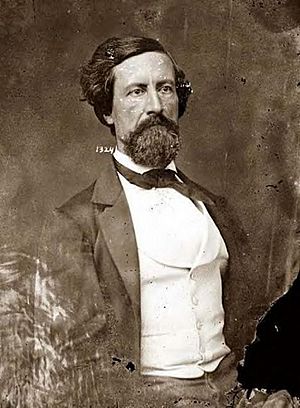
Vicksburg was very important for the Confederates. Confederate President Jefferson Davis called it "the nail head that holds the South's two halves together." As long as the Confederates held Vicksburg, Union ships could not travel freely down the Mississippi River. Vicksburg also helped the Confederates communicate with states west of the river. These states provided horses, cattle, and soldiers.
The city had strong natural defenses. It was on a high cliff overlooking a bend in the river. This made it very hard to attack by ship. North and east of Vicksburg was the Mississippi Delta. This area had many waterways and thick wilderness. It was very difficult for soldiers to move through. About 12 miles up the Yazoo River, Confederates had strong defenses at Haynes Bluff. The land west of Vicksburg in Louisiana was also difficult. It had many streams and poor roads.
Union forces had tried to attack Vicksburg before. In May 1862, Admiral David Farragut demanded Vicksburg's surrender. But he did not have enough soldiers to force it. He returned in June 1862 and tried to bombard the city. This also failed. Farragut even tried digging a canal to bypass the city. But the work was stopped due to disease and heat.
In late 1862, Maj. Gen. Henry Halleck told Grant to make a big move against Vicksburg. Grant decided on a two-part attack. Sherman would go down the river, and Grant would go overland.
Confederate forces in Mississippi were led by Lt. Gen. John C. Pemberton. He had about 12,000 men in Vicksburg. Another 24,000 men were at Grenada.
Meanwhile, President Abraham Lincoln knew Vicksburg was key. He said, "Vicksburg is the key. ...The war can never be brought to a close until that key is in our pocket." Lincoln also wanted a two-part attack. But he wanted one force to go down the river and another to come up from New Orleans.
Early Battles and Failed Attempts (December 1862 – January 1863)
The first part of the Vicksburg campaign included these battles:
Battle of Chickasaw Bayou (December 26–29, 1862)
Sherman's troops landed on the Yazoo River to attack Vicksburg from the northeast. On December 27, they tried to push through swamps toward the Walnut Hills. These hills were strongly defended by Confederates. On December 29, Sherman ordered a direct attack. It was pushed back with heavy losses for the Union, and Sherman's forces had to retreat.
At the same time, Grant's overland attack was failing. Confederate raids destroyed his supplies at Holly Springs. Without supplies, Grant had to stop his overland advance.
Battle of Arkansas Post (January 9–11, 1863)
In January, Maj. Gen. John Alexander McClernand arrived with his troops. He took command of Sherman's corps and planned an attack on Fort Hindman. This fort was on the Arkansas River. Confederate gunboats from there were attacking Union ships.
Union boats, led by Rear Adm. David Dixon Porter, landed troops near Arkansas Post. On January 10, Porter's fleet bombarded Fort Hindman. On January 11, Union artillery fired on the fort. Union soldiers moved into position to attack. The Confederate command surrendered that afternoon. This victory removed another threat to Union shipping on the Mississippi.
Grant was not happy about this attack because it was done without his approval. But since it was successful, he did not punish anyone. He then took personal command of the Vicksburg campaign on January 13.
Grant's Bayou Operations (January–March 1863)
During the winter, Grant tried several ways to reach Vicksburg. These were called "Grant's bayou operations." The idea was to use or build new waterways. This would allow troops to get close to Vicksburg without facing the city's powerful cannons directly.
Grant's Canal
A canal had been started earlier to bypass Vicksburg. In January 1863, Sherman's men began digging again. Grant ordered the canal to be made wider and deeper. But the Mississippi River rose suddenly and flooded the area. The canal filled with water and mud. Efforts to clear it failed, and Confederate artillery fire made it impossible to continue. By late March, work on the canal was stopped.
Other Failed Attempts
Grant tried other water routes, like the Lake Providence expedition, the Yazoo Pass expedition, and Steele's Bayou expedition. All of these attempts faced problems. They were blocked by low water, fallen trees, or strong Confederate defenses. These efforts showed how difficult it was to move troops and boats through the swampy areas around Vicksburg.
By March, Grant had tried seven different plans, and all had failed. Grant later said he did these experiments to keep his troops busy during the winter. But his letters at the time show he really hoped they would work.
Grant's New Plan (1863)
All the water operations failed. But Grant was determined. His new plan was bold and risky. He would march his army down the west side of the Mississippi River. Then, they would cross the river south of Vicksburg. From there, they could attack Vicksburg from the south and east.
Admiral Porter's gunboats and transport ships would have to sneak past Vicksburg's cannons. Once they were past, they could not go back upstream.
On March 29, Grant's troops began building roads and bridges. By April 17, they had a rough 70-mile road. This road went from Milliken's Bend to a crossing point south of Vicksburg.
On April 16, Porter sent seven gunboats and three empty transport ships past Vicksburg. It was a clear, moonless night. But Confederate guards saw the boats. The bluffs exploded with artillery fire. Fires were lit along the banks to see better. The Union gunboats fired back. Porter noticed that the Confederates mostly hit the high parts of his boats. He realized they could not aim their guns low enough. So, he had his boats hug the east shore, right under the Confederate cannons. The fleet survived with little damage. Only 13 men were wounded, and none were killed.
Grant also used two diversions to fool the Confederates. Sherman made a fake attack north of Vicksburg. This made Pemberton keep many troops near the city. Also, Colonel Benjamin Grierson led a daring cavalry raid through central Mississippi. This raid drew many Confederate forces away to chase him. These diversions worked perfectly. They made Pemberton unsure of Grant's real plan.
Forces Involved
Union Army
Maj. Gen. Ulysses S. Grant's Army of the Tennessee started the campaign with about 44,000 soldiers. By July, it grew to 75,000. It was made up of five corps.
Confederate Army
Lt. Gen. John C. Pemberton's Confederate Army of Mississippi had about 30,000 men. General Joseph E. Johnston had another 6,000 men in Raymond and Jackson. Johnston's forces grew to about 36,000 by the time Vicksburg surrendered.
Grant's Main Operations (April – July 1863)
This phase of the campaign included these important battles:
Battle of Grand Gulf (April 29, 1863)
Admiral Porter's ironclads attacked Confederate forts at Grand Gulf, Mississippi. They wanted to silence the guns so McClernand's troops could land. The attack lasted for hours. The Union ships got very close to the Confederate guns. But the upper batteries kept firing. Grant and Porter decided it was too hard to land troops there. They moved downstream.
Later that night, the ironclads fought the Confederate guns again. The steamboats and barges ran past the defenses. Grant marched his men overland to meet them. They landed 17,000 soldiers at Bruinsburg, Mississippi. This was the largest amphibious operation in American military history until D-Day.
Battle of Port Gibson (May 1, 1863)
Grant's army marched inland from Bruinsburg. They met Confederate outposts after midnight. The fighting continued until dawn. Union forces pushed the Confederates back. The Confederates tried to set up new defenses but could not stop the Union advance. They left the field in the early evening. This victory secured the Union's landing spot.
Grant then decided to attack Vicksburg directly. He sent his three corps to attack the railroad from Jackson to Vicksburg. This would cut off Vicksburg's supplies.
Battle of Raymond (May 12, 1863)
Confederate Brig. Gen. John Gregg's brigade marched to Raymond. On May 12, Gregg's men tried to ambush a Union raiding party. But it turned out to be a large Union division. Gregg's men fought bravely for six hours. But the Union forces were too strong and forced them to retreat. This battle exposed the railroad to Union forces, cutting Vicksburg's supply line.
Battle of Jackson (May 14, 1863)
Gen. Johnston arrived in Jackson to take command. He learned that two Union corps were advancing on the city. Johnston ordered Jackson to be evacuated. But Gregg's small force had to defend the city until the evacuation was complete.
By 10 a.m., Union forces were near Jackson. They pushed the Confederates back. In the afternoon, Johnston told Gregg to leave. Union troops entered Jackson and destroyed factories and railroad connections. The fall of the state capital was a big blow to Confederate morale. Grant then focused his troops on Vicksburg.
Battle of Champion Hill (May 16, 1863)
On May 16, Union forces met Pemberton's army at Champion Hill. Pemberton's men were in a defensive line. Grant ordered an attack. By 11:30 a.m., Union forces reached the main Confederate line. They took the hill, and the Confederates began to retreat.
One Confederate division counterattacked, pushing the Union forces back. But Grant sent in more troops. Pemberton's men could not hold. He ordered them to retreat toward Vicksburg. Union troops captured the crossroads, cutting off one escape route. The Confederates were in full retreat.
Battle of Big Black River Bridge (May 17, 1863)
The Confederate retreat reached the Big Black River Bridge. Pemberton ordered three brigades to defend the east bank. Union forces attacked on the morning of May 17. Union Brig. Gen. Michael K. Lawler's brigade charged the Confederate defenses. They broke through the lines.
Confused and panicked, the Confederates began to cross the river on two bridges. As soon as they crossed, they set fire to the bridges. This stopped the Union pursuit. The Union forces captured about 1,800 Confederate soldiers. This was a huge loss for the Confederates.
Siege of Vicksburg (May 18 – July 4, 1863)
The Union army surrounded Vicksburg, trapping Pemberton's forces inside. Grant tried two direct attacks on May 19 and May 22. The second attack caused 3,200 Union casualties and failed. Johnston ordered Pemberton to leave the city, but Pemberton thought it was impossible.
Grant then began a siege. For six weeks, the soldiers and people of Vicksburg had no food supplies. They were constantly bombarded by Union cannons. On July 4, Pemberton surrendered the city and his army.
Grant also had to worry about Confederate forces behind him. He sent troops to stop Johnston from interfering with the siege. Johnston tried to move to help Pemberton. But he delayed too long, and it was too late for Vicksburg.
Louisiana Operations
During the siege of Vicksburg, some other battles happened nearby:
Battle of Milliken's Bend (June 7, 1863)
Confederates attacked the Union supply area at Milliken's Bend. This area was mostly defended by untrained African-American troops. They fought bravely with older weapons. With help from Union gunboats, they finally pushed back the Confederates.
Battle of Helena (July 4, 1863)
Confederate Lt. Gen. Theophilus H. Holmes attacked Helena, Arkansas. He hoped to relieve pressure on Vicksburg. The Confederates had more troops and captured some forts. But the Union forces pushed them back.
Aftermath of the Campaign
The Vicksburg campaign was a huge victory for the Union. Grant captured almost 30,000 Confederate soldiers. He also took many cannons, guns, and ammunition. The total losses for the campaign were 10,142 Union and 9,091 Confederate killed and wounded.
This was the second major blow to the Confederacy in the summer of 1863. On July 3, Gen. Robert E. Lee's invasion of the North failed at Gettysburg. On July 4, the American flag flew over Vicksburg. Surrendering on Independence Day was a very bitter defeat for the Confederates.
The most important result was that the Union now controlled the entire Mississippi River. After Port Hudson surrendered on July 9, the Confederacy was cut in two. President Lincoln famously said, "The Father of Waters again goes unvexed to the sea." This meant Union ships could travel freely from the Midwest to the Gulf of Mexico.
Grant sent Sherman and 50,000 troops to attack Johnston's army in Jackson. Johnston escaped with his army, but all of central Mississippi was now under Union control. Grant was rewarded for his victory. He was promoted to major general in the regular army. He also received a special letter from President Lincoln. Lincoln admitted he had doubted Grant's plan but was wrong.
Grant went on to lead the Union armies to victory in the war. Historians often call Vicksburg his finest campaign. It was imaginative, bold, and a masterpiece of military strategy.
The blame for losing Vicksburg fell on both John Pemberton and Joseph E. Johnston. Many in the South were angry at Pemberton. They even accused him of treachery because he surrendered on July 4. Johnston was also criticized for not coming to Vicksburg's aid. However, Johnston was greatly outnumbered by Grant's forces.
Images for kids
See also
 In Spanish: Campaña de Vicksburg para niños
In Spanish: Campaña de Vicksburg para niños


